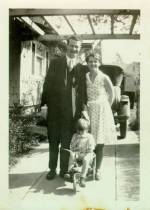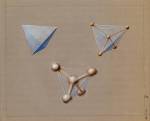| "People Won’t Believe It." |
|
In his 1928 note, Pauling proposed an explanation based on Heitler and London’s electron
exchange energy. Each time a new bond was created, new exchange energy was involved.
The electron exchange energy resulting from forming four tetrahedral bonds, he wrote,
was sufficient to break carbon’s four binding electrons out of the physicists’ subshells
and allow them to assume new, equivalent forms.
This was an exciting idea, but one that would have to be backed up with considerable
mathematics. Pauling didn’t present any in his note, however, writing that "the detailed
account of the material mentioned in this note will be submitted for publication in
the Journal of the American Chemical Society."
Nearly three years would pass before Pauling’s "detailed account" appeared. In 1928
he had worked through enough convoluted
calculations to convince himself, at least preliminarily, that his idea was right,
but "it was so complicated that I thought people won’t believe it," he said. "And
perhaps I don’t believe it, either. . . . Anybody could see that the quantum mechanics
must lead to the tetrahedral carbon atom, because we have it. But the equations were
so complicated that I never could be sure that I could present the arguments in such
a way that they would be convincing to anybody."
|
|
Click images to enlarge

Linus, Ava Helen, and Linus Pauling Jr. posing in their driveway. 1928.

Pastel drawing of Methane. 1964.
"I'd begun to think about the theory of the chemical bond very seriously in 1926,
'27, after quantum mechanics was discovered and then in 1928 I published a paper,
a preliminary paper, and said that I would write more later on. I didn't write anything
more for three years because the problem turned out to be such a hard problem, the
mathematical problem, that I couldn't solve it."
|

